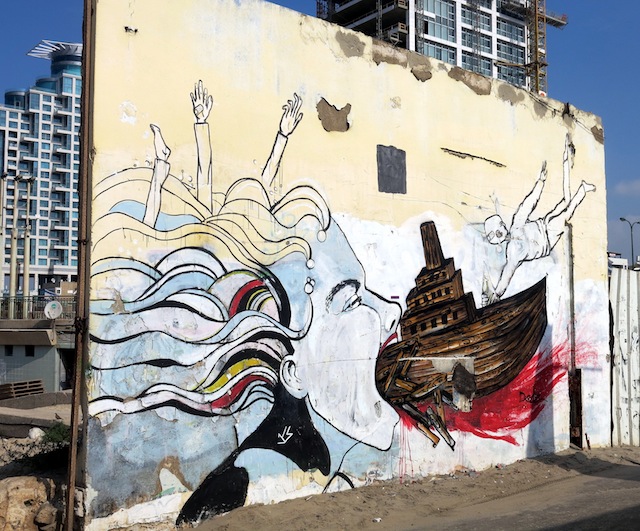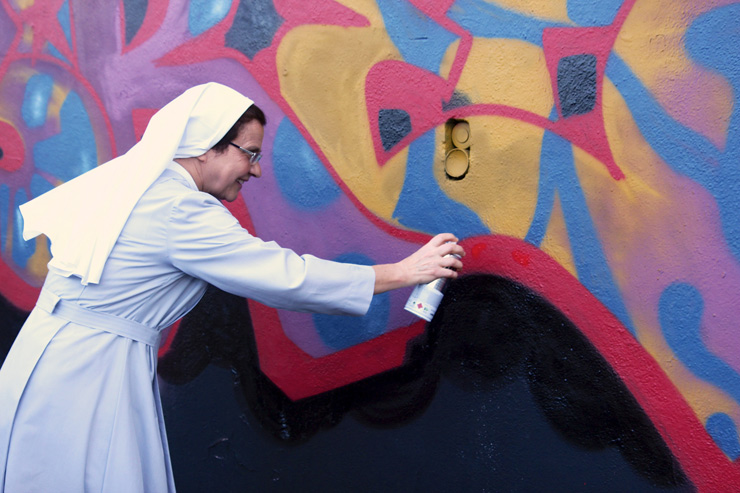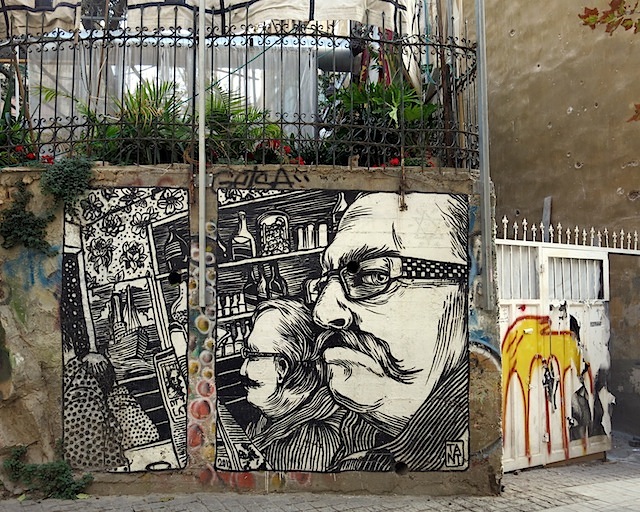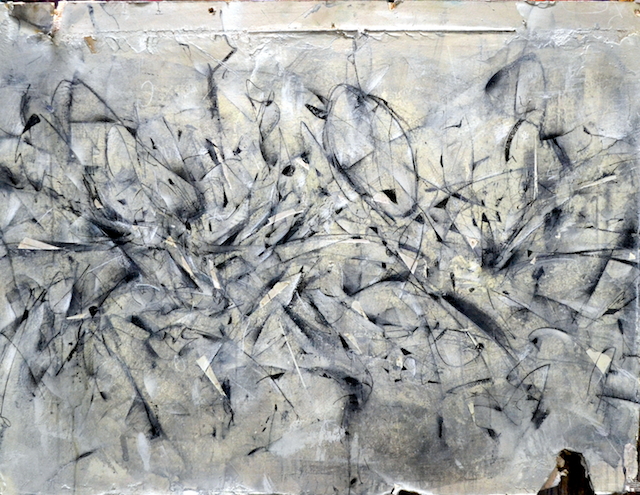Tuesday, December 31, 2013
Othello & the Hipknotics
*I may be wrong but I'm under the impression that Othello is a member of "Jehovah's witness". This is an album that fuses jazz and hip hop really well and Othello is a very good lyricist. The album, while enjoyable, makes you think whether Othello would place himself within the "Christian hip hop" category.
Feminist Graffiti in Bolivia
Monday, December 30, 2013
Rappers and the Police 2000-2010
"After an analysis of a random sample of hip-hop songs released on
platinum-selling albums between 2000 and 2010, Steinmetz and Henderson
concluded that the main law enforcement-related themes in hip-hop are
not pleasure and pride in aggressive and criminal acts, but the
unfairness of the criminal justice system and the powerlessness felt by
those targeted by it."
source
source
Friday, December 27, 2013
Roman Nun and Graffiti
Thursday, December 26, 2013
Monday, December 23, 2013
Saturday, December 21, 2013
Friday, December 20, 2013
Thursday, December 19, 2013
Tuesday, December 17, 2013
Evolution of Hip-Hop music in Korea
Korean hip-hop can be said to have started in the early 90s with Seotaiji and Boys. This is really an important group that changed the face of Korean music. All of K-Pop can probably be traced back down to these guys. They first became influential in the early 90s and continued to have a significant impact on the Korean music scene as they introduced a stream of new genres into Korea.
Here, I'll just cover the decade from the early 90s to 2000-01 when Psy makes his debut. To be honest, I ceased to pay much attention after the 2000s.
Although rap was around in the early 90s, I think hip-hop really took off with this song:
1992
they even rendered it in English:
Kim Gun Mo also enters the scene in 1992
(though he would progress in a different direction musically):
In 1993, we see Deux:
In 1994, enter DJ Doc:
In 1995, Seotaiji and Boys bring in a form of gangster rap (mimicking Cypress Hill):
In 1997, after Seotaiji and Boys broke up, Yang Hyun Suk (YG) began setting up his own label. He subsequently introduced Jinusean:
We also see in 1997 the debut of Yoo Seung Jun:
Uptown also enters the scene this year:
*97 became the year when we begin to see Koreans raised in other countries - namely the U.S. - coming into Korea and making a splash on the music. This trend continues on throughout the rest of the 90s and into the 2000s.
Outside of this immigration, we also have Kim Jin Pyo (JP) who makes his solo debut in 97:
In 1998,
1TYM (the second group to go on board with YG):
JP releases his 2nd album in 98 and we get a glimpse of Drunken Tiger:
In 1999, Drunken Tiger splashes the scene. Tiger JK from this group along with Tasha from Uptown would go on to really be big figures for Korean hip-hop.
Honey Family also comes into the picture in 1999
In 2000-01, the infamous Psy makes his debut:
*there might be a few (Noize, Goofy, R.e.f, Turbo, H.O.T, G.O.D, and a few momentary groups like People Crew) I missed but I think I hit the pivotal figures who would go on to shape K-pop and Korean hip-hop. They do play with the border between boy-band k-pop group and hip-hop.
Here, I'll just cover the decade from the early 90s to 2000-01 when Psy makes his debut. To be honest, I ceased to pay much attention after the 2000s.
Although rap was around in the early 90s, I think hip-hop really took off with this song:
1992
they even rendered it in English:
Kim Gun Mo also enters the scene in 1992
(though he would progress in a different direction musically):
In 1993, we see Deux:
In 1994, enter DJ Doc:
In 1995, Seotaiji and Boys bring in a form of gangster rap (mimicking Cypress Hill):
In 1997, after Seotaiji and Boys broke up, Yang Hyun Suk (YG) began setting up his own label. He subsequently introduced Jinusean:
We also see in 1997 the debut of Yoo Seung Jun:
Uptown also enters the scene this year:
*97 became the year when we begin to see Koreans raised in other countries - namely the U.S. - coming into Korea and making a splash on the music. This trend continues on throughout the rest of the 90s and into the 2000s.
Outside of this immigration, we also have Kim Jin Pyo (JP) who makes his solo debut in 97:
In 1998,
1TYM (the second group to go on board with YG):
JP releases his 2nd album in 98 and we get a glimpse of Drunken Tiger:
In 1999, Drunken Tiger splashes the scene. Tiger JK from this group along with Tasha from Uptown would go on to really be big figures for Korean hip-hop.
Honey Family also comes into the picture in 1999
In 2000-01, the infamous Psy makes his debut:
*there might be a few (Noize, Goofy, R.e.f, Turbo, H.O.T, G.O.D, and a few momentary groups like People Crew) I missed but I think I hit the pivotal figures who would go on to shape K-pop and Korean hip-hop. They do play with the border between boy-band k-pop group and hip-hop.
Tunisia: Klay BBJ and Weld EL 15
They received some attention in Foreign Policy after performing a song: 'Boulicia Kleb' (Police are Dogs).
Game ft. Jadakiss, Styles P & AR-16 - Last Supper
According to Rap Radar this track was supposed to be on his last album 'Jesus Piece'.
Game talks about this album here
Sub-series: Religion and Hip-Hop
While this blog was initially setup to gather and collect data that could reflect a cyber-fieldwork for a "unofficial anthropology" of hip-hop (which will continue), I also want to begin a sub-series within this line of reasoning on the intersections of religion and hip-hop. I have already made a few blog posts that play on this interface but wanted to make a more conscientious focus on gathering representations within hip-hop culture that make this connection more explicit. Not only will I begin looking for this interface in music but in the other areas of hip-hop culture as well. Furthermore, there will also be an attempt to look for online discussions about this topic of religion and hip-hop.
The themes for this series will include the incorporation of religion in hip-hop culture, the incorporation of hip-hop in religious culture, and thirdly the question of whether we can consider hip-hop as a religion.
The series will be noted "religion and hip-hop" as a label to the posts (I will be going back adding this label), and hopefully I can keep it going.
The themes for this series will include the incorporation of religion in hip-hop culture, the incorporation of hip-hop in religious culture, and thirdly the question of whether we can consider hip-hop as a religion.
The series will be noted "religion and hip-hop" as a label to the posts (I will be going back adding this label), and hopefully I can keep it going.
Sunday, December 15, 2013
"Rick Ross"
It is not uncommon for rappers to adopt an alias and create a public name. In fact, most rappers have an alias. Another practice is to take on the name of a political figure. Tupac donned the name 'Makavelli' at one point and other members of the Outlawz also took on similar names: Napolean, E.D.I Mean, Kastro, Kadafi. Other rappers have taken names such as Jon Gotti and other famous past names of infamous gangsters.
Others take on a twist of their own name. One contemporary case is an interesting play on this practice of taking on an alias. Rick Ross.
This is a name that could be his own. But in fact, the name is lifted directly from a big drug dealer in the 80s. If you've watched some of the documentaries about crack and hip hop, you will have come across the name Rick Ross. I haven't listened to much of the rapper Rick Ross but according to the real Rick Ross, the rapper has lifted much of the stories from the real Rick Ross who pushed crack cocaine and became a major king pin until he was arrested.
Read more about the real Rick Ross here:
http://noisey.vice.com/blog/freeway-rick-ross-autobiography-interview
Others take on a twist of their own name. One contemporary case is an interesting play on this practice of taking on an alias. Rick Ross.
This is a name that could be his own. But in fact, the name is lifted directly from a big drug dealer in the 80s. If you've watched some of the documentaries about crack and hip hop, you will have come across the name Rick Ross. I haven't listened to much of the rapper Rick Ross but according to the real Rick Ross, the rapper has lifted much of the stories from the real Rick Ross who pushed crack cocaine and became a major king pin until he was arrested.
Read more about the real Rick Ross here:
http://noisey.vice.com/blog/freeway-rick-ross-autobiography-interview
Saturday, December 14, 2013
Thursday, December 12, 2013
Venezuela: Apache y Canserbero
"A music video made in Venezuela this year calls attention to a special kind of crime: corruption by Venezuelan police.
Two rappers who go by the names Apache and Canserbero show themselves driving a beat-up Lincoln, maybe from the 1970s. They're pulled over at a checkpoint by cops who want cash."
More here
Wednesday, December 11, 2013
Graffuturism
work by Poesia
In an interview @ Vandalog:
RJ: In one sentence, what makes someone a graffuturist?
Poesia: Most likely an artist with a graffiti background who has evolved and progressed beyond his initial roots.
RJ: I guess I always thought about Graffuturism as having to do with graffiti writers going in an abstract direction, but with this show you’ve included a lot of artists known for figurative works and made it clear in your artist statement that the movement isn’t purely about an abstract aesthetic. Can you go into a bit more detail on the similarities you see between say Sainer and Clemens Behr?
Poesia: Many people get this part of Graffuturism confused, but I feel it is because graffiti artists tend to move in a more abstract direction due to graffiti’s initial abstract nature. When compared to street art that already is more representational, Graffiti was and is an abstract form of art already. But we have to remember that graffiti has always used representational images cartoon characters etc since the early days of graffiiti, most the artists that were more inclined to paint representational or figurative work would get character or background duty on walls. Many of these talented artists never learned proper letters because they were always busy painting the backgrounds for the letter artists. One of the positive byproducts of Street Art was that now all these talented representational painters who had painted graffiti characters forever now saw that they could take center stage and create their own work without letters. This was an important evolution of graffiti and thus an artist like Sainer is just as an evolved graffiti artist as Clemens Behr who moved into a more abstract avenue of work. Both have this history that has evolved and thrived in a new age where painting whatever you like is possible without adhering to the traditional rules of graffiti. To me they are the same even if aesthetically polar opposites. The reason why Graffuturism is seen as an abstract movement is more due to the fact that there were more letterbased artists than figurative artists that have gone onto progress thus the surplus of abstract artists versus figurative ones.
Tuesday, December 10, 2013
Sunday, December 8, 2013
Friday, December 6, 2013
N.W.A.
I'm not entirely sure, but my hunch is that N.W.A started the 'Gangster Rap' movement.
Straight Outta Compton (1988)
Straight Outta Compton (1988)
Thursday, December 5, 2013
Tuesday, December 3, 2013
Sunday, December 1, 2013
"What About Holy Hip Hop?"
Panelists are asked about their thoughts on reformed rap artists.
Their responses are quite revealing...
(if the image before clicking the video isn't foreshadow enough...)
Their responses are quite revealing...
(if the image before clicking the video isn't foreshadow enough...)
Subscribe to:
Comments (Atom)












